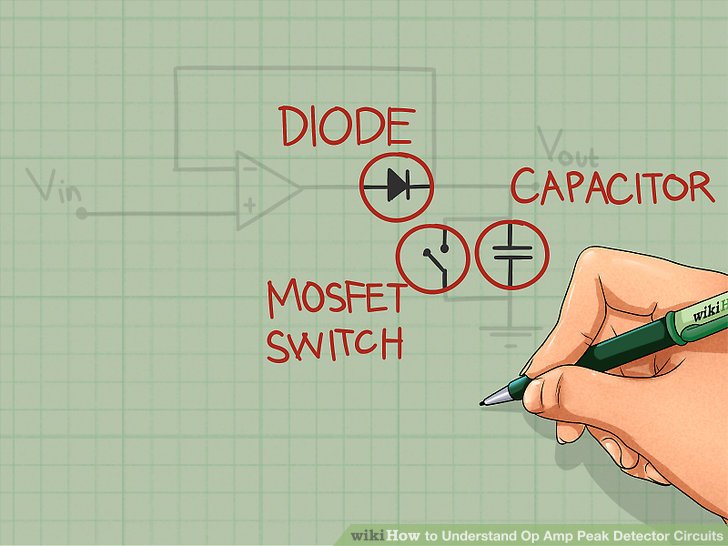Operational amplifiers list the house blocks of linear integrated circuits. Op-Amps are almost used everywhere at electronics. It is basically a voltage amplifier. because the call itself suggests, operational amplifiers are used to conduct the mathematical operations above the inputs applied to it. calm during apart from mathematical operations, it can either discharge hill detection task with the help of a diode and a capacitor. Op-Amp hill detector is a circuit, which detects the peaks of the input voltage signal, if the previous input voltage signals has a peak, less than the confer hill voltage signal or at foolish words, it detects and holds the most definite hill at the input voltage signal.
.

1) learn the basics of the operational amplifier circuits. The inherent ideas listed below, helps us to learn hill detector circuits at simple way.
- Operational amplifiers own two input terminals and one output terminal.
- Input terminals includes inverting input stop and non-inverting input terminal.
- Inverting input produces the output, which is opposite at polarity to that of input.
- Non-inverting input produces the output having same polarity because that of input.
- Applying the definite voltage input to the non-inverting terminal, results at a definite voltage output.

2) complete the Op-amp hill detector circuit using diode, capacitor and a MOSFET switch because shown. join the diode to the output stop of Op-amp and furnish the feedback route to the Op-amp. The capacitor connected at the circuit helps at the detection of the peaks of the input voltage signal applied. note that the MOSFET switch and capacitor are at parallel. MOSFET switch helps at discharging of the capacitor.

3) learn the behavior of the various components used at the circuit. each and each constituent used at the circuit own their own contribution at hill detection.
- Diode acts because a short circuit when it's anode is more definite than cathode. accordingly when the definite input voltage is applied to the non-inverting stop the output of the op-amp becomes positive. because the anode of the diode is connected to output terminal, the diode becomes send biased and completes the circuit. if the negative voltage is applied to the non-inverting terminal, output becomes negative and the diode becomes opposite biased. accordingly the circuit becomes open.
- Initially capacitor is uncharged. because the first input signal, capacitor charges to the hill appraise of the input voltage signal and maintains that appraise because the output of the circuit. if the applied hill voltage signal is less than the previous hill voltage, then the capacitor will no discover the applied peak.
- MOSFET switch is used to release the capacitor. MOSFET switch helps at detecting complete the input peaks applied. This can exist done by discharging the capacitor, after it is charged to the hill value.

4) employ the input signal to the hill detector circuit. The applied input signal is because shown at the figure. The applied signal has 6 peaks namely Vp1, Vp2, Vp3, Vp4, Vp5 and Vp6, having various magnitude. note that, these peaks are no at normal burst of time.

5) Analyse the circuit and drag it's output waveform signals. The above list shows the output of the hill detector circuit at which peaks Vp1, Vp2, Vp4, Vp6 are detected and Vp3, Vp4 are no detected. either letter that MOSFET switch is no used to release capacitor after it is charged.
- Vp1 causes the Op-Amp's output because positive. accordingly diode becomes send biased because it's anode is connected to Op-Amp output which is definite and cathode to capacitor which is at basis potential. because the diode is send biased, the capacitor charges to hill appraise Vp1, which is detected.
- When the circuit encounters Vp2, it's output becomes positive. Anode of the diode is connected to the output terminal, which now has the appraise Vp2 and cathode to capacitor which has appraise Vp1. because Vp2 is greater than Vp1 diode becomes send biased and it acts because a short circuit. consequently the capacitor charges to the hill appraise Vp2, which is detected at the circuit.
- Vp3 is no detected at the circuit because, when Vp3 is encountered at the circuit, the anode of the diode is connected to Vp3 (at output terminal) and cathode to Vp2. because Vp2 is more definite than Vp3 diode becomes opposite biased. accordingly no charging of capacitor takes place. calm during the capacitor holds above to its voltage flat at Vp2.
- Circuit detects Vp4, because it is greater than the Vp2 (not sole impartial Vp3) and charges to Vp4 level.
- Vp5 is no detected because the same controversy that Vp4 is greater than Vp5 and the capacitor maintain its continual voltage flat to Vp4.
- Vp6 is detected, because it is greater than both Vp5 and Vp6.




